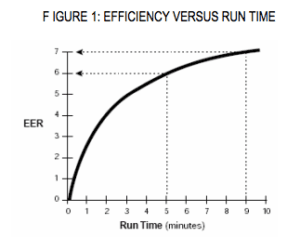Sizing & Installation
RIGHT-SIZED AIR CONDITIONERS: MECHANICAL EQUIPMENT IMPROVEMENTS
The ENERGY STAR Program promotes right-sized air conditioners where heating and cooling contractors carefully match system capacity to home cooling needs. Homes that include features such as increased insulation, air sealing, high-performance windows, and improved duct systems can dramatically reduce cooling loads. As a result, smaller, less costly air conditioners can usually be installed.
It is common for contractors to install oversized air conditioners because these units provide cooling more quickly, thus avoiding any chance of not meeting the cooling demand. However, oversized air conditioners “short-cycle” or run for shorter periods of time than engineered for optimum operation. The efficiency of air conditioners is low when they first start and increases gradually, reaching peak efficiency in about 10 minutes.
As shown in Figure 1 below, when operating time increases from 5 to 9 minutes, efficiency improves 17 percent. In this example, the energy efficiency ratio (EER) increases from 6 to 7. In addition, bursts of cold air from oversized units can trick the thermostats into shutting off the system before the whole house is cool. Moreover, short operation times do not allow the system to effectively remove humidity with serious repercussions on both home comfort and durability.

Air conditioning accounts for 13 percent of total home energy expenses on average and over 20 percent in hot humid regions. A right-sized air conditioner is an important part of an energy-efficient home and will result in improved comfort, durability, and lower utility bills. RIGHT-SIZED AIR CONDITIONERS MECHANICAL EQUIPMENT IMPROVEMENTS
BENEFITS
Installing right-sized air conditioners can provide many benefits including:
Improved comfort. Right-sized air conditioners supply conditioned air at a lower volume and over a longer period of time than oversized units. This allows the conditioned air to gradually mix into the space and reduces cold drafts near the supply registers. In addition, right-sized air conditioners provide better dehumidification. These features maintain a more consistent level of comfort throughout a house.
Better humidity control. In order for air conditioners to dehumidify or dry the air, they have to cycle long enough for moisture to condense on the coils and drain away. With oversized units, short-cycling reduces the amount of condensation that drains off the coils and even allows some moisture to evaporate back into the air. Air that is not properly dehumidified can be uncomfortable and promotes the growth of mold
and mildew indoors.
Quieter home. Right-sized air conditioners deliver smaller volumes of air over longer periods of time. This reduces indoor noise caused when conditioned air moves through ducts and registers at high speeds and when systems frequently start and stop. In addition, right-sized air conditioners require smaller compressor and fan motors which reduce indoor and outdoor noise when these components are
operating.
Lower utility bills. Energy consumption increases with the size of air conditioners and decreases with system efficiency. Short-cycling prevents air conditioners from operating at peak efficiency. Thus, right-sized units provide an equivalent amount of space cooling for less energy consumed. This results in lower utility bills.
Fewer maintenance problems. Short-cycling increases wear and tear. Other maintenance problems, such as dirty filters, leaky ducts, and improper refrigerant charge, are masked by the large output of oversized units. These problems can increase the amount and magnitude of maintenance required by air conditioners and possibly shorten their lives. Since right-sized air conditioners short-cycle less frequently,
these maintenance costs are reduced and other maintenance problems are more apparent and more likely to be corrected.
ENERGY STAR® promotes the use of high-efficiency technologies and equipment to help homeowners improve the energy efficiency of their homes. ENERGY STAR is sponsored by the U.S. Environmental Protection Agency and the U.S. Department of Energy

